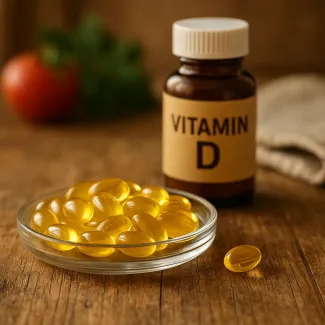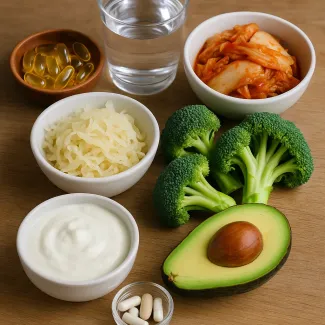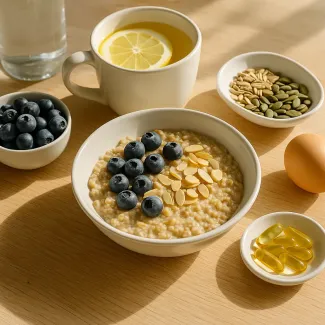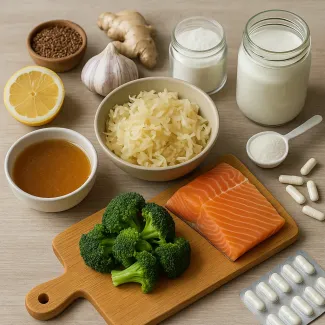
Natural strategies to restore optimal vitamin D levels in your daily life
How to safely improve your vitamin D status through food, sunlight and smart supplementation
Vitamin D plays a crucial role in maintaining bone strength, immune function, and overall vitality, yet many people unknowingly live with suboptimal levels. Fatigue, weakened immunity, poor muscle function, and low mood are just a few symptoms associated with insufficient vitamin D. Since this nutrient is not abundantly available in food and depends heavily on sun exposure, understanding how to boost your vitamin D levels effectively and safely is key to better long-term health.
Understanding why vitamin D deficiency is so widespread
Modern lifestyles, with increased indoor time and heavy sunscreen use, have led to a noticeable drop in natural vitamin D synthesis. In northern latitudes, low UVB exposure during winter makes it nearly impossible to produce sufficient vitamin D through sunlight alone. Even in sunny regions, people may avoid midday sun due to skin cancer concerns or spend most of their day indoors.
Furthermore, age, skin pigmentation, weight, and gut health influence how well vitamin D is absorbed or activated. For example, darker skin reduces the rate of vitamin D production, while excess body fat may store vitamin D and make it less available to the body. Recognizing these factors can help tailor a more effective approach to restoring healthy vitamin D levels.
The difference between vitamin D2 and D3: What to choose
There are two primary forms of vitamin D found in supplements: vitamin D2 (ergocalciferol) and vitamin D3 (cholecalciferol). D2 is usually derived from plants and fungi, whereas D3 is typically extracted from animal sources like lanolin or fish oil.
Scientific consensus supports that vitamin D3 is more effective at raising and maintaining circulating levels of vitamin D in the body. For this reason, most high-quality supplements and clinical protocols now prefer D3, particularly when dealing with deficiency. Some vegan-friendly D3 options sourced from lichen are now available, offering a plant-based alternative that is equally bioavailable.
How much vitamin D do you really need daily?
Daily vitamin D needs vary based on age, body weight, location, and sun exposure. In general, adults need 1,000 to 4,000 IU (25 to 100 mcg) daily for maintenance, with higher doses required during winter months or for people with limited sun exposure. Some experts suggest that obese individuals or those with malabsorption may need up to 10,000 IU temporarily under medical supervision.
Blood testing (serum 25(OH)D) is the only way to precisely assess your vitamin D status, but general guidelines recommend maintaining levels between 30 and 50 ng/mL for overall health. Those looking to optimize for immune resilience or mental clarity often aim for the upper end of this range.
Can you get enough vitamin D from food alone?
Vitamin D is one of the few nutrients that’s difficult to obtain in sufficient amounts through diet alone. While certain foods contain vitamin D naturally or are fortified, the levels are often too low to meet daily requirements.
Some of the best dietary sources include:
- Fatty fish such as salmon, sardines, mackerel, and tuna
- Cod liver oil, which offers a potent dose in small quantities
- Fortified dairy products, plant milks, and breakfast cereals
- Egg yolks and beef liver in moderate amounts
- Mushrooms exposed to UV light, particularly maitake and portobello
Despite these options, relying solely on food often results in less than 20% of the necessary intake, making supplementation and sensible sun exposure essential strategies for most people.
The role of sun exposure: How to do it right
Vitamin D is often referred to as the “sunshine vitamin” because the body can synthesize it when skin is exposed to UVB rays. However, multiple factors influence how much vitamin D you can produce, including:
- Time of day: Midday sun (10am–2pm) provides the most effective UVB exposure
- Geographic location: The further from the equator, the lower the intensity of UVB, especially in winter
- Skin tone: Darker skin requires longer exposure due to higher melanin levels
- Age: Older adults produce less vitamin D despite the same exposure
- Use of sunscreen or clothing: These can block over 90% of UVB rays
As a rule of thumb, exposing arms and legs for 15–30 minutes, 3–4 times per week, can significantly improve vitamin D status. However, always balance this with skin protection and cancer risk awareness. For those in colder climates or with limited sun exposure, supplementation becomes the main source.
Best practices for taking vitamin D supplements
Taking vitamin D with a meal that includes fat significantly improves absorption. Since it’s a fat-soluble vitamin, consuming it with oils, nuts, eggs, or fatty fish enhances bioavailability. For best results, take vitamin D supplements:
- In the morning or with lunch to align with the body's natural hormone rhythms
- With healthy fats to maximize uptake
- Consistently, at the same time each day
Some people may experience better results with daily low doses, while others benefit from weekly higher-dose regimens. The choice depends on personal preference, compliance, and any medical advice provided.
Do you need vitamin K2 with your vitamin D?
Vitamin K2 works synergistically with vitamin D to help direct calcium to the bones and teeth rather than soft tissues and arteries. When increasing vitamin D intake, especially at higher doses, pairing it with vitamin K2 (MK-7 form) can reduce the risk of unwanted calcium deposits and improve bone health.
This combination is especially recommended for:
- Individuals at risk of osteoporosis or arterial calcification
- Those taking more than 2,000 IU of vitamin D daily for extended periods
- Anyone with a high-calcium diet or supplementation protocol
Taking a combined D3 + K2 supplement simplifies the routine and supports more balanced mineral metabolism.
How magnesium supports vitamin D metabolism
Magnesium is a key cofactor for vitamin D metabolism, activating the enzymes that convert it into its active form. Without adequate magnesium, vitamin D may remain inactive, even if blood levels appear normal.
Magnesium-rich foods like pumpkin seeds, almonds, spinach, black beans, and dark chocolate can support this synergy. In cases of deficiency, a magnesium supplement may be necessary to fully benefit from vitamin D supplementation.
Signs your vitamin D levels are too low
Deficiency can manifest subtly or with pronounced symptoms, including:
- Chronic fatigue and low energy
- Frequent infections or illnesses
- Bone pain or muscle weakness
- Hair loss
- Low mood or mild depression
These signs are often mistaken for other conditions, making it important to be mindful of risk factors like limited sun exposure, age, darker skin, and certain health conditions that impair absorption.
Groups most at risk of vitamin D deficiency
While anyone can be affected, some populations are more vulnerable:
- Older adults, particularly those in care homes
- People with darker skin tones
- Individuals with obesity or diabetes
- Those with digestive disorders like celiac, Crohn’s, or IBS
- Vegans and vegetarians, due to limited dietary sources
- Individuals who cover most of their skin for cultural or medical reasons
These groups often require higher intake or more targeted supplementation to reach optimal vitamin D levels.
Should you take vitamin D year-round?
In most regions with seasonal sunlight variation, vitamin D production is insufficient for several months of the year. Supplementing from autumn to spring is standard in northern areas, though many choose to maintain a lower maintenance dose even in summer to avoid fluctuations.
Consistent intake ensures that energy, mood, and immune strength remain stable, regardless of seasonal changes.
Liquid, capsules, or sprays: Which form is most effective?
Vitamin D supplements come in various forms, and absorption rates can differ. Here’s what to consider:
- Liquid drops are absorbed quickly and allow flexible dosing
- Capsules are convenient and widely used, especially with softgel formulations containing oil
- Oral sprays offer a direct alternative for those with digestion issues or difficulty swallowing pills
The most important factor remains regular use and proper absorption, so choosing a form that fits your lifestyle and habits is key to long-term success.
Combining vitamin D with other immune-supporting nutrients
While vitamin D is powerful on its own, it often works better alongside other immune-supporting nutrients. These include:
- Zinc, which boosts immune response and fights infections
- Vitamin C, a known antioxidant and immune enhancer
- Omega-3 fatty acids, which help reduce inflammation
- Probiotics, which improve gut function and nutrient absorption
This combination supports not only bone and immune health, but also mood, brain function, and inflammation control.
Can vitamin D improve mood and mental health?
There is growing interest in the link between vitamin D and mental well-being. Low levels have been associated with:
- Seasonal affective disorder (SAD)
- Mild depression and irritability
- Cognitive decline in older adults
Boosting vitamin D levels has shown potential in improving emotional balance, mental clarity, and energy levels, particularly in those previously deficient.
What time of year is vitamin D deficiency most common?
Late winter and early spring are peak times for low vitamin D levels in most parts of the world. After months of minimal sunlight, the body’s reserves are often depleted. Symptoms like fatigue, frequent colds, or mood swings tend to increase during this time, making it a strategic season to focus on supplementation and sun exposure planning.
The impact of vitamin D on hormone balance
Vitamin D functions as a prohormone, influencing the activity of multiple hormones in the body. It plays a role in:
- Regulating thyroid function
- Supporting testosterone and estrogen balance
- Enhancing insulin sensitivity and blood sugar regulation
Optimizing vitamin D can indirectly support metabolic, reproductive, and mood-related hormones, especially in individuals over 30, where hormonal shifts become more pronounced.
How gut health affects vitamin D absorption
A healthy gut lining and balanced microbiome are essential for proper nutrient uptake, including vitamin D. Issues like leaky gut, low stomach acid, or dysbiosis can hinder absorption, even with adequate intake.
Supporting gut health through:
- Fermented foods like kimchi, sauerkraut, and kefir
- Prebiotic fibers from garlic, onions, leeks, and asparagus
- Digestive enzymes if needed
can enhance your body’s ability to process and utilize vitamin D more efficiently.
Can children and teens benefit from vitamin D supplements?
Growing children and adolescents need sufficient vitamin D for bone development, immune defense, and mood regulation. Modern screen time habits and sunscreen use can reduce their sun exposure, making supplementation especially important during growth spurts or winter months.
Pediatric dosages are generally lower, and chewables, drops, or sprays are commonly used. Parents should monitor signs of fatigue, irritability, or frequent illness, which may signal deficiency.
Lifestyle habits that support vitamin D optimization
To naturally maintain healthy levels, consider these daily habits:
- Spend time outdoors in early afternoon sunlight
- Eat fat-rich vitamin D foods regularly
- Take your supplement with meals containing fat
- Support gut health and magnesium intake
- Monitor how you feel seasonally, adjusting doses as needed
Consistency is the key to avoiding both deficiency and excessive fluctuation.





